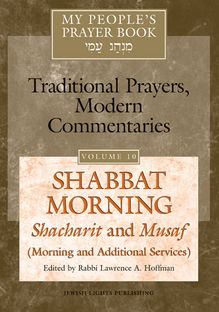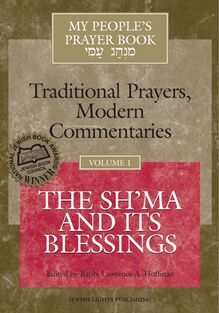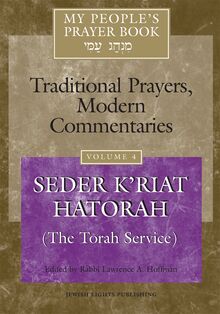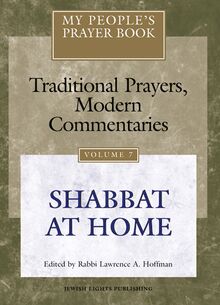-
 Univers
Univers
-
 Ebooks
Ebooks
-
 Livres audio
Livres audio
-
 Presse
Presse
-
 Podcasts
Podcasts
-
 BD
BD
-
 Documents
Documents
-
- Cours
- Révisions
- Ressources pédagogiques
- Sciences de l’éducation
- Manuels scolaires
- Langues
- Travaux de classe
- Annales de BEP
- Etudes supérieures
- Maternelle et primaire
- Fiches de lecture
- Orientation scolaire
- Méthodologie
- Corrigés de devoir
- Annales d’examens et concours
- Annales du bac
- Annales du brevet
- Rapports de stage
La lecture à portée de main
Vous pourrez modifier la taille du texte de cet ouvrage
Découvre YouScribe en t'inscrivant gratuitement
Je m'inscrisDécouvre YouScribe en t'inscrivant gratuitement
Je m'inscrisEn savoir plus
Vous pourrez modifier la taille du texte de cet ouvrage
En savoir plus

Description
"The prayer book is our Jewish diary of the centuries, a collection of prayers composed by generations of those who came before us, as they endeavored to express the meaning of their lives and their relationship to God. The prayer book is the essence of the Jewish soul."
My People's Prayer Book provides diverse and exciting commentaries to the traditional liturgy, written by some of today's most respected scholars and teachers from all perspectives of the Jewish world. They explore the text from the perspectives of ancient Rabbis and modern theologians, as well as feminist, halakhic, medieval, linguistic, biblical, Chasidic, mystical, and historical perspectives.
This stunning work, an empowering entryway to the spiritual revival of our times, enables all of us to claim our connection to the heritage of the traditional Jewish prayer book. It helps rejuvenate Jewish worship in today's world, and makes its power accessible to all. The My People's Prayer Book series belongs on the library shelf of every home, every synagogue—every sanctuary of prayer.
Introductions tell the reader what to look for in the prayer service, as well as how to truly use the commentaries, to search for—and find—meaning in the prayer book.
ABOUT MY PEOPLE'S PRAYER BOOK PRAYER AS PETITION: THE PHILOSOPHIC BASIS FOR HALAKHIC PRAYER Daniel Landes INTRODUCTION TO THE LITURGY: WHAT TO LOOK FOR IN THE SERVICE Lawrence A. Hoffman HOW THE AMIDAH BEGAN: A JEWISH DETECTIVE STORY Lawrence A. Hoffman THE GENIZAH FRAGMENTS: HOW OUR ANCESTORS PRAYED IN THE ANCIENT LAND OF ISRAEL Joel M. Hoffman. INTRODUCTION TO THE COMMENTARIES: HOW TO LOOK FOR MEANING IN THE PRAYERS Lawrence A. Hoffman THE LITURGY 1. OPENING MEDITATION. 2. THE AMIDAH A. BLESSINGS OF PRAISE. 1. AVOT ("ANCESTORS") 2. G’VUROT (“GOD’S POWER”) ˇQ˝ÍÊ7 3. K’DUSHAT HASHEM (“SANCTIFICATION OF GOD’S NAME”) B. BLESSINGS OF PETITION 4. BINAH (“KNOWLEDGE”) 5. T’SHUVAH (“REPENTANCE”) 6. S’LICHAH (“FORGIVENESS”) 7. G’ULAH (“REDEMPTION”) 8. R’FU’AH (“HEALING”) 9. SHANIM (“YEARS”) 10. KIBBUTZ GALUYOT (“GATHERING THE EXILES”) 11. MISHPAT (“JUSTICE”) 12. MINIM (“HERETICS”) 13. TSADIKIM (“THE RIGHTEOUS”) 14. Y’RUSHALAYIM (“JERUSALEM”) 15. DAVID (“DAVID”) 16. T’FILLAH (“PRAYER”) C.BLESSINGS OF THANKSGIVING 17. AVODAH (“SACRIFICIAL SERVICE”) 18. HODA’AH (“GRATEFUL ACKNOWLEDGMENT”) 19. BIRKAT KOHANIM/SHALOM (“THE PRIESTLY BLESSING/PEACE”) 3. CLOSING MEDITATION 4. THE HAVINEINU About the Commentators List of Abbreviations Glossary
Sujets
Informations
| Publié par | Turner Publishing Company |
| Date de parution | 05 juin 2013 |
| Nombre de lectures | 0 |
| EAN13 | 9781580237581 |
| Langue | English |
| Poids de l'ouvrage | 1 Mo |
Informations légales : prix de location à la page 0,0700€. Cette information est donnée uniquement à titre indicatif conformément à la législation en vigueur.
Extrait
R ead may be the wrong word. Engage would be better, because this is not so much a book as it is a classic text, and Jewish classics are not read so much as they are engaged. Included here is a classic text of Jewish prayer, spanning 2,000 years of Jewish experience with the world and with God; and nine thoughtful commentaries on that text, each one reaching back in a different way, again through 2,000 years of time. The question ought to be, Who should engage this book in personal dialogue?
If you like to pray, or find prayer services baffling: Whether you are Orthodox, Conservative, Reconstructionist, or Reform, you will find that My People s Prayer Book tells you what you need to know to pray. The Hebrew text here is the most authentic one we have, and the variations among the Jewish movements are described and explained. They are all treated as equally authentic. The translation is honest, altogether unique, and outfitted with notes comparing it to others translations. Of special interest is a full description of the Halakhah (the how to ) of prayer and the philosophy behind it.
If you are a spiritual seeker or Jewishly curious: If you have wondered what Judaism is all about, the prayer book is the place to begin. It is the one and only book that Jews read each and every day. The commentaries explain how the prayers were born, and synopsize insights of founding Rabbis, medieval authorities, Chasidic masters, and modern theologians. The layout replicates the look of Jewish classics: a text surrounded by many marginal commentaries allowing you to skip back and forth across centuries of insight.
If you are a teacher or a student: This is a perfect book for adult studies, or for youth groups, teenagers, and camps. Any single page provides comparative insight from the length and breadth of Jewish tradition, about the texts that have mattered most in the daily life of the Jewish people.
If you are a scholar: Though written in friendly prose, this book is composed by scholars: professors of Bible, Rabbinics, Medieval Studies, Liturgy, Theology, Linguistics, Jewish Law, Mysticism, and Modern Jewish Thought. No other work summarizes current wisdom on Jewish prayer, drawn from so many disciplines.
If you are not Jewish: You need not be Jewish to understand this book. It provides access for everyone to the Jewish wisdom tradition. It chronicles the ongoing Jewish-Christian dialogue, and the roots of Christian prayer in Christianity s Jewish origins.
The My People s Prayer Book: Traditional Prayers, Modern Commentaries series Volume 1- The Sh ma and Its Blessings 168 pp, 978-1-879045-79-8 Volume 2- The Amidah 240 pp, 978-1-879045-80-4 Volume 3- P sukei D zimrah (Morning Psalms) 240 pp, 978-1-879045-81-1 Volume 4- Seder K riat Hatorah (The Torah Service) 264 pp, 978-1-879045-82-8 Volume 5- Birkhot Hashachar (Morning Blessings) 240 pp, 978-1-879045-83-5 Volume 6- Tachanun and Concluding Prayers 240 pp, 978-1-879045-84-2 Volume 7- Shabbat at Home 240 pp, 978-1-879045-85-9 Volume 8- Kabbalat Shabbat (Welcoming Shabbat in the Synagogue) 240 pp, 978-1-58023-121-3 Volume 9- Welcoming the Night: Minchah and Ma ariv (Afternoon and Evening Prayer) 272 pp, 978-1-58023-262-3 Volume 10- Shabbat Morning: Shacharit and Musaf (Morning and Additional Services) 240 pp, 978-1-58023-240-1
Prayers of Awe Volume 1- Who by Fire, Who by Water- Un taneh Tokef 272 pp, 978-1-58023-424-5 Volume 2- All These Vows- Kol Nidre 288 pp, 978-1-58023-430-6 Volume 3- We Have SinnedSin and Confession in Judaism- Ashamnu and Al Chet 288 pp, 978-1-58023-612-6 Volume 4- May God Remember: Memory and Memorializing in Judaism- Yizkor 250 pp (est), 978-1-58023-689-8
My People s Passover Haggadah: Traditional Texts, Modern Commentaries Volume 1- 304 pp, 978-1-58023-354-5 Volume 2- 320 pp, 978-1-58023-346-0
Thank you for purchasing this Jewish Lights e-book!
Sign up for our e-newsletter to receive special offers and information on the latest new books and other great e-books from Jewish Lights.
Sign Up Here
or visit us online to sign up at www.jewishlights.com .
Looking for an inspirational speaker for an upcoming event, Shabbaton or retreat?
Jewish Lights authors are available to speak and teach on a variety of topics that educate and inspire. For more information about our authors who are available to speak to your group, visit www.jewishlights.com/page/category/JLSB . To book an event, contact the Jewish Lights Speakers Bureau at publicity@jewishlights.com or call us at (802) 457-4000.
Prayer As Petition: The Philosophic Basis for Halakhic Prayer Daniel Landes
Introduction to the Liturgy: What to Look for in the Service Lawrence A. Hoffman
How the Amidah Began: A Jewish Detective Story Lawrence A. Hoffman
The Genizah Fragments: How Our Ancestors Prayerd in the Ancient Land of Israel Joel M. Hoffman
Introduction to the Commentaries: How to Look for Meaning in the Prayers Lawrence A. Hoffman
THE LITURGY
1. Opening Meditation
2. The Amidah
A. Blessings of Praise
1. Avot ( Ancestors )
2. G vurot ( God s Power )
3. K dushat Hashem ( Sanctification of God s Name )
B. Blessings of Petition
4. Binah ( Knowledge )
5. T shuvah ( Repentance )
6. S lichah ( Forgiveness )
7. G ulah ( Redemption )
8. R fu ah ( Healing )
9. Shanim ( Years )
10. Kibbutz G luyot ( Gathering of the Exiles )
11. Mishpat ( Justice )
12. Minim ( Heretics )
13. Tsadikim ( The Righteous )
14. Y rushalayim ( Jerusalem )
15. David ( David )
16. T fillah ( Prayer )
C. Blessings of Thanksgiving
17. Avodah ( Sacrificial Service )
18. Hoda ah ( Grateful Acknowledgment )
19. Birkat Kohanim/Shalom ( The Priestly Blessing/Peace )
Closing Meditation
The Havineinu
About the Commentators
Glossary
About the Editor
About My People s Prayer Book
Copyright
Also Available
About Jewish Lights
Sign Up for E-mail Updates
Send Us Your Feedback
Commentators Marc Brettler Our Biblical Heritage Elliot N. Dorff Theological Reflections David Ellenson How the Modern Prayer Book Evolved Marcia Falk Feminist Theology Judith Hauptman Talmudic Traditions Joel M. Hoffman What the Prayers Really Say Lawrence A. Hoffman Origins of the Liturgy Lawrence Kushner And Nehemia Polen Chasidic and Mystical Perspectives Daniel Landes The Halakhah of Prayer
Halakhah speaks a language of obligation and form. Applied to prayer ( t fillah ) , the concerns of obligation include the questions of who should pray and what are the circumstances that compel it. The concerns of form are when prayer is uttered, where one should pray, and how it should be said. Surprisingly, Halakhah seems to not really address the question of why prayer is necessary, but to assume instead that it is sufficient to command this religious requirement.
Defenders of Halakhah often say that this is quite enough. According to their reasoning, Halakhah provides sufficient context within which to ask all questions of meaning, including the ones regarding the rationale behind prayer. Therefore, if one obeys the Halakhah by praying the required liturgy three times a day, and if one commits the time and attention to it that the Law demands, the meaning behind prayer will become clear. It will either spring up from the Siddur (prayer book) itself or make itself manifest in other ways, usually of a pronounced spiritual nature, such as mysticism. Alternatively, one might attach another religious practice to t fillah, such as prior Torah study or meditation, that somehow unlocks the deeper experience of prayer. Simply put, according to this defense, the Halakhah is absolutely necessary for the Jewish institution of prayer and for the individual who prays but is itself actually insufficient to achieve a profound t fillah experience.
This defense of the Halakhah actually sells it short. It pictures the Halakhah s manifold rulings regarding prayer as a series of obstacles that need to be overcome. No wonder that many who wish to pray and are impatient with requirements in general attempt to bypass the Halakhah. This is a pity, for Halakhah contains within itself the key that unlocks the deeper meanings and dynamics of prayer. Halakhah rivals and is more profound than even the archly spiritual sources of Judaism such as mysticism, with which it often conflicts.
Halakhic Versus Spiritual Prayer
A paradigmatic example of the collision between halakhic and mystical understandings of prayer finds its focus in the first recorded communal prayer. The king of Egypt died and the children of Israel sighed by reason of the bondage, and they cried out and their plea rose up to God by reason of the bondage. And God heard their groaning and God remembered his covenant with Abraham, with Isaac and with Jacob (Exod. 2:23–24). A plain reading of the text demonstrates a cause and effect-the redemption of the people beginning with God s remembering his covenant is the result of the entreaty of the people. If they had not prayed, they would not have been redeemed. Prayer thus becomes the activating cause for the central event in Jewish history-the Exodus. But what was the nature of the prayer? Here spirituality and Halakhah differ.
The Zohar (Exod. 20a, the primary document for Jewish mysticism) heaps lavish praise on the spontaneous prayer that arises directly from the human heart and claims, therefore, that the t fillah of Exodus was effective because it was the outpouring of the individual soul: Rabbi Judah said: Of all the three expressions for prayer used in the Exodus narrative, crying o
-
 Univers
Univers
-
 Ebooks
Ebooks
-
 Livres audio
Livres audio
-
 Presse
Presse
-
 Podcasts
Podcasts
-
 BD
BD
-
 Documents
Documents
-
Jeunesse
-
Littérature
-
Ressources professionnelles
-
Santé et bien-être
-
Savoirs
-
Education
-
Loisirs et hobbies
-
Art, musique et cinéma
-
Actualité et débat de société
-
Jeunesse
-
Littérature
-
Ressources professionnelles
-
Santé et bien-être
-
Savoirs
-
Education
-
Loisirs et hobbies
-
Art, musique et cinéma
-
Actualité et débat de société
-
Actualités
-
Lifestyle
-
Presse jeunesse
-
Presse professionnelle
-
Pratique
-
Presse sportive
-
Presse internationale
-
Culture & Médias
-
Action et Aventures
-
Science-fiction et Fantasy
-
Société
-
Jeunesse
-
Littérature
-
Ressources professionnelles
-
Santé et bien-être
-
Savoirs
-
Education
-
Loisirs et hobbies
-
Art, musique et cinéma
-
Actualité et débat de société
- Cours
- Révisions
- Ressources pédagogiques
- Sciences de l’éducation
- Manuels scolaires
- Langues
- Travaux de classe
- Annales de BEP
- Etudes supérieures
- Maternelle et primaire
- Fiches de lecture
- Orientation scolaire
- Méthodologie
- Corrigés de devoir
- Annales d’examens et concours
- Annales du bac
- Annales du brevet
- Rapports de stage













